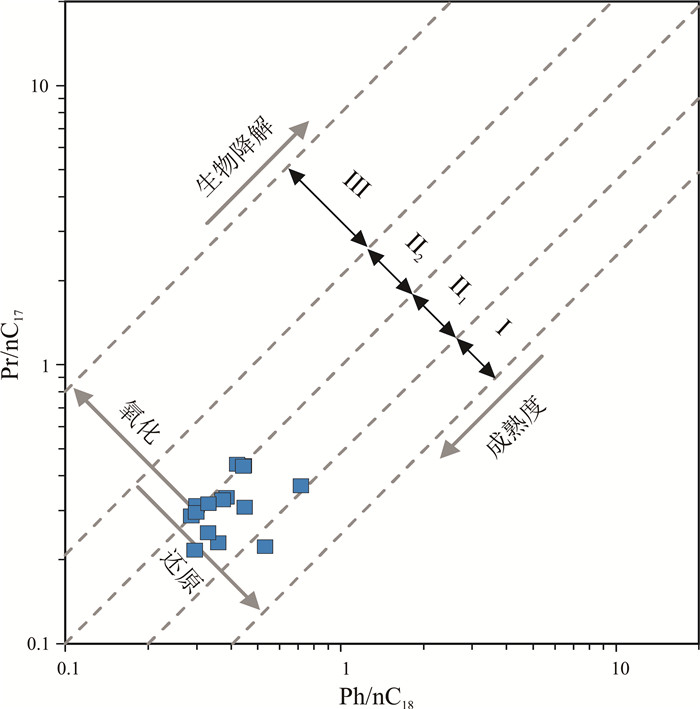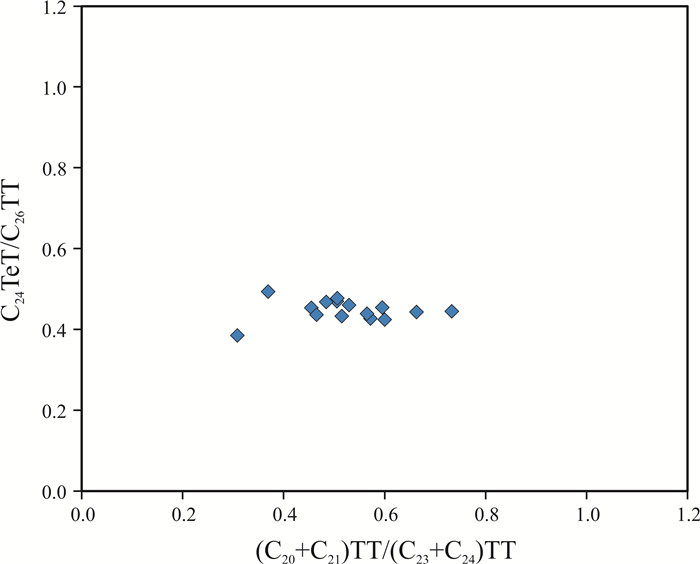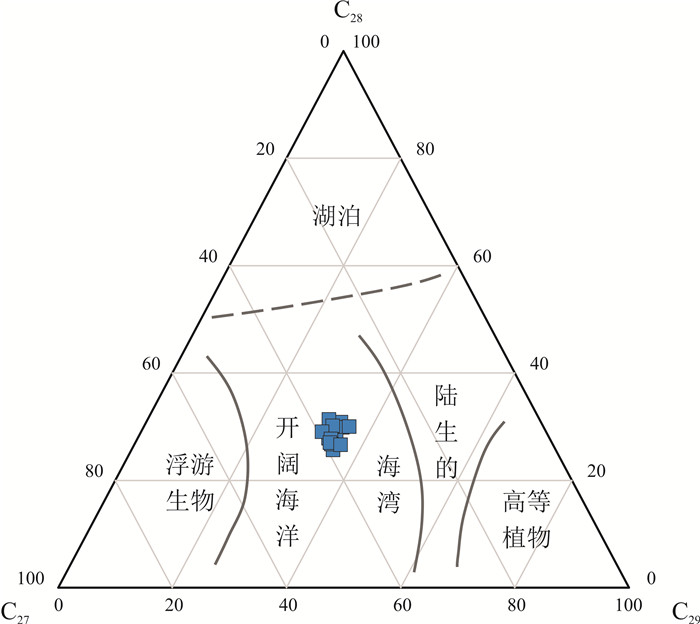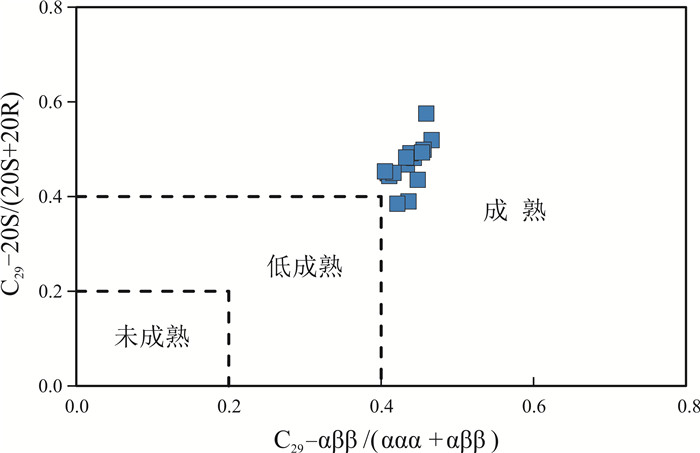BIOMARKER CHARACTERISTICS AND IMPLICATION OF THE MESOPROTEROZOIC GAOYUZHUANG FORMATION IN LIAOXI DEPRESSION OF YANLIAO RIFT ZONE
-
摘要:
燕辽裂陷带辽西拗陷多口钻井钻遇油气显示,使得该地区中-新元古界的古老海相地层再次成为油气勘探及研究的焦点.采用气相色谱、气相色谱-质谱技术,对辽凌地1井中元古界高于庄组岩心样品开展烃源岩生物标志化合物研究,据此分析了其生源信息、沉积环境及生烃潜力.综合分析认为,辽凌地1井高于庄组属于差-中等烃源岩,有机质类型Ⅱ1型,整体处于成熟-高成熟阶段,已大量生排烃.高于庄组烃源岩饱和烃的正构烷烃碳数分布呈前单峰型,主峰碳多为nC17,具有C27规则甾烷优势,指示其母质输入以低等生物为主.综合萜烷类化合物分布特征,推测高于庄组生源主要为低等菌藻类.另外,较高的伽马蜡烷含量、较低的Pr/Ph比值,反映出高于庄组烃源岩主体形成于咸水还原环境,个别层位可能为强还原环境.
Abstract:The oil-gas shows found in several bore wells in Liaoxi Depression of Yanliao Rift Zone bring the Meso-Neoproterozoic marine strata in the area once again into the focus of oil-gas exploration and research. Both gas chromatography and gas chromatography-mass spectrometry are used to study the biomarkers of source rocks from Mesoproterozoic Gaoyuzhuang Formation in LLD1 well, and analyze the organic matter source, sedimentary environment, and hydrocarbon generation potential. Through comprehensive analysis, it is considered that Gaoyuzhuang Formation belongs to poor-medium grade source rocks, as organic type of Ⅱ1, generally in mature-high mature stage with mass generation and expulsion of hydrocarbon. The carbon number distribution of n-alkanes in saturated hydrocarbon is pre-unimodal. The main peak carbon is mostly nC17, with the advantage of C27 regular sterane, indicating that the parent material input is dominated by lower organism. Combined with the distribution characteristics of terpanes, it is inferred that the main organic source is low bacteria algae. Moreover, the high gammacerane content and low Pr/Ph ratio reflect the main source rocks of Gaoyuzhuang Formation were formed in salt water reduction environment, with certain layers possibly in strongly reduced environment.
-
Key words:
- biomarker /
- hydrocarbon generation potential /
- Gaoyuzhuang Formation /
- source rock /
- Liaoxi Depression
-

-
表 1 辽凌地1井高于庄组烃源岩地球化学分析数据表
Table 1. Geochemical data of the source rocks of Gaoyuzhuang Formation in LLD1 well
序号 样品编号 岩性 TOC/% Tmax /℃ (S1+S2)/10-3 残余碳/10-3 产率指数 δ13C/‰ 氯仿沥青“A”/% 1 LLD1-1080.4 灰岩 0.51 488 0.33 0.22 0.42 -31.0 0.016 2 LLD1-1090.4 灰质白云岩 0.53 494 0.44 1.44 0.41 -32.7 0.024 3 LLD1-1150.0 白云质灰岩 1.83 477 2.00 5.37 0.27 -31.1 0.037 4 LLD1-1156.8 灰岩 0.61 423 0.46 13.38 0.26 -32.5 0.021 5 LLD1-1193.0 灰质白云岩 1.00 475 0.81 16.40 0.37 -31.4 0.037 6 LLD1-1217.6 灰岩 0.58 439 0.58 13.69 0.28 -30.8 0.021 7 LLD1-1258.2 白云质灰岩 0.78 483 0.58 7.41 0.34 -30.9 0.031 8 LLD1-1279.9 白云质灰岩 0.88 457 0.52 9.12 0.25 -30.4 0.025 9 LLD1-1290.8 灰岩 0.55 481 0.42 5.68 0.36 -31.0 0.011 10 LLD1-1298.5 灰岩 0.83 490 0.28 3.83 0.39 -31.7 0.022 11 LLD1-1368.9 白云质灰岩 0.57 432 0.41 11.64 0.17 -32.0 0.027 12 LLD1-1409.3 灰岩 0.29 287 0.26 5.71 0.31 -32.2 0.024 13 LLD1-1454.4 白云质灰岩 0.77 482 0.83 14.34 0.27 -32.7 0.032 表 2 辽凌地1井高于庄组烃源岩生物标志物参数表
Table 2. Biomarker parameters of the source rocks of Gaoyuzhuang Formation in LLD1 well
样品编号 CPI OEP ∑nC21- /∑nC22+ Pr/nC17 Ph/nC18 Pr/Ph Ts/Tm Ga/C30H C24TeT/C26TT (C20+C21)TT/(C23+C24)TT C29-αββ/(αββ+ααα) 主峰碳数 LLD1-1080.4 1.06 0.96 1.32 0.25 0.33 1.08 0.94 0.12 0.45 0.45 0.44 nC18 LLD1-1090.4 1.23 1.18 1.54 0.43 0.45 0.99 0.95 0.16 0.48 0.51 0.44 nC17 LLD1-1150.0 1.09 0.81 2.92 0.22 0.30 0.99 0.95 0.15 0.49 0.37 0.47 nC16 LLD1-1156.8 1.17 1.17 1.28 0.31 0.45 0.81 0.89 0.14 0.47 0.48 0.41 nC17 LLD1-1193.0 1.05 1.09 2.33 0.33 0.39 1.02 0.84 0.17 0.44 0.73 0.46 nC18 LLD1-1217.6 0.97 1.05 1.45 0.44 0.42 0.96 0.68 0.15 0.42 0.60 0.43 nC17 LLD1-1258.2 0.99 1.14 1.51 0.29 0.29 1.21 0.87 0.12 0.44 0.46 0.45 nC17 LLD1-1279.9 1.03 0.92 1.75 0.22 0.53 0.55 0.83 0.13 0.45 0.60 0.46 nC18 LLD1-1290.8 1.10 1.11 1.85 0.33 0.37 0.99 0.87 0.18 0.43 0.51 0.41 nC17 LLD1-1298.5 1.07 1.18 3.14 0.31 0.30 1.20 0.73 0.11 0.43 0.57 0.45 nC17 LLD1-1368.9 1.03 1.29 1.23 0.43 0.44 0.91 0.82 0.17 0.44 0.57 0.42 nC17 LLD1-1409.3 1.19 1.18 1.85 0.30 0.30 1.05 0.71 0.13 0.44 0.66 0.42 nC17 LLD1-1454.4 1.04 1.04 1.25 0.32 0.33 1.05 0.62 0.13 0.46 0.53 0.40 nC17 -
[1] Kelly A E, Love G D, Zumberge J E, et al. Hydrocarbon biomarkers of Neoproterozoic to lower Cambrian oils from eastern Siberia[J]. Organic Geochemistry, 2011, 42(6):640-654. doi: 10.1016/j.orggeochem.2011.03.028
[2] Millson J A, Quin J G, Idiz E, et al. The Khazzan gas accumulation, a giant combination trap in the Cambrian Barik sandstone member, sultanate of Oman:Implications for Cambrian petroleum systems and reservoirs[J]. AAPG Bulletin, 2008, 92(7):885-917. doi: 10.1306/02210807100
[3] 陈斐然, 张颖, 徐祖新, 等.全球前寒武-寒武系含油气盆地石油地质特征及成藏主控因素[J].吉林大学学报(地球科学版), 2017, 47(4):974-989. https://www.cnki.com.cn/Article/CJFDTOTAL-CCDZ201704002.htm
Chen F R, Zhang Y, XuZ X, et al. Petroleum geological characteristics and main control factors of oil and gas accumulations in the global Precambrian-Cambrian petroliferous basin[J]. Journal of Jilin University (Earth Science Edition), 2017, 47(4):974-989. https://www.cnki.com.cn/Article/CJFDTOTAL-CCDZ201704002.htm
[4] 孙枢, 王铁冠.中国东部中-新元古界地质学与油气资源[M].北京:科学出版社, 2016.
Sun S, Wang T G. Geology and hydrocarbon resources of Mesoproterozoic and Neoproterozoic in Eastern China[M]. Beijing:ChinaScience Publishing, 2016. (in Chinese)
[5] 王铁冠, 韩克猷.论中-新元古界的原生油气资源[J].石油学报, 2011, 32(1):1-7. https://www.cnki.com.cn/Article/CJFDTOTAL-SYXB201101002.htm
Wang T G, Han K Y. On Meso-Neoproterozoic primary petroleum resources[J]. Acta Petrolei Sinica, 2011, 32(1):1-7. https://www.cnki.com.cn/Article/CJFDTOTAL-SYXB201101002.htm
[6] Sun Q S, Xiao F, Gao X Y, et al. A new discovery of Mesoproterozoic Erathem oil, and oil-source correlation in the Niuyingzi area of western Liaoning Province, NE China[J]. Marine and Petroleum Geology, 2019, 110:606-620. doi: 10.1016/j.marpetgeo.2019.07.048
[7] Tang Y J, Li M J, Zhu Q G, et al. Geochemical characteristics and origin of hydrocarbons in the Mesoproterozoic reservoirs in the Liaoxi Depression, NE China[J]. Energy Exploration & Exploitation, 2019, 38(2):333-347. http://www.researchgate.net/publication/334445840_Geochemical_characteristics_and_origin_of_hydrocarbons_in_the_Mesoproterozoic_reservoirs_in_the_Liaoxi_Depression_NE_China?ivk_sa=1024320u
[8] 宗文明, 孙求实, 郜晓勇.辽西牛营子凹陷中元古界铁岭组烃源岩地球化学特征[J].地质论评, 2019, 65(S1):209-210. https://www.cnki.com.cn/Article/CJFDTOTAL-DZLP2019S1102.htm
Zong W M, Sun Q S, Gao X Y. Geochemical characteristics of middle Proterozoic Tieling formation source rocks in Niuyingzi sag, Western Liaoning[J]. Geological Review, 2019, 65(S1):209-210. (in Chinese) https://www.cnki.com.cn/Article/CJFDTOTAL-DZLP2019S1102.htm
[9] 宗文明, 郜晓勇, 孙求实, 等.华北北部凌源-宁城盆地蓟县系洪水庄组生烃潜力分析——以小庄户剖面为例[J].地质与资源, 2017, 26(4):370-376. doi: 10.3969/j.issn.1671-1947.2017.04.007 http://manu25.magtech.com.cn/Jweb_dzyzy/CN/abstract/abstract8555.shtml
ZongW M, GaoX Y, Sun Q S, et al. Evaluation of the hydrocarbon generating potential of the Jixianian Hongshuizhuang Formation in Lingyuan-Ningcheng Basin, Northern China:A case study of Xiaozhuanghu geological profile[J]. Geology and Resources, 2017, 26(4):370-376. doi: 10.3969/j.issn.1671-1947.2017.04.007 http://manu25.magtech.com.cn/Jweb_dzyzy/CN/abstract/abstract8555.shtml
[10] 郑磊, 唐友军, 李永飞, 等.凌源-宁城盆地牛营子地区辽凌D1井高于庄组烃源岩地球化学特征[J].石油天然气学报, 2019, 41(1):19-25.
Zheng L, Tang Y J, Li Y F, et al. The geochemical characteristics of source rock of the Gaoyuzhuang Formation of well LLD1 in Niuyingzi area of Lingyuan-Ningcheng basin[J]. Journal of Oil and Gas Technology, 2019, 41(1):19-25.
[11] Hongzhen W, Qiao X F. Proterozoic stratigraphy and tectonic framework of China[J]. Geological Magazine, 1984, 121(6):599-614. doi: 10.1017/S0016756800030740
[12] 柳永清, 刘晓文, 李寅.燕山中、新元古代裂陷槽构造旋回层序研究——兼论裂陷槽构造旋回概念及级序的划分[J].地球学报, 1997, 18(2):142-149. https://www.cnki.com.cn/Article/CJFDTOTAL-DQXB702.004.htm
Liu Y Q, Liu X W, Li Y. Tectonic cyclic sequences in the Mesoproterozoic and Neoproterozoic aulacogen of Yanshan-A concept of aulacogen tectonic cycle and its hierarchy[J]. Acta Geoscientica Sinica, 1997, 18(2):142-149. https://www.cnki.com.cn/Article/CJFDTOTAL-DQXB702.004.htm
[13] 乔秀夫, 高林志.燕辽裂陷槽中元古代古地震与古地理[J].古地理学报, 2007, 9(4):337-352. doi: 10.3969/j.issn.1671-1505.2007.04.001
Qiao X F, Gao L Z. Mesoproterozoic palaeoearthquake and palaeogeography in Yan-Liao Aulacogen[J]. Journal of Palaeogeography, 2007, 9(4):337-352. doi: 10.3969/j.issn.1671-1505.2007.04.001
[14] 郝石生, 高耀斌, 张有成, 等.华北北部中-上元古界石油地质学[M].北京:石油大学出版社, 1990:54-61.
Hao S S, Gao Y B, Zhang Y C, et al. Middle upper Proterozoic petroleum geology in northern North China[M]. Beijing:China University of Petroleum Press, 1990:54-61. (in Chinese)
[15] 刘宝泉, 梁狄刚, 方杰, 等.华北地区中上元古界、下古生界碳酸盐岩有机质成熟度与找油远景[J].地球化学, 1985(2):150-162. doi: 10.3321/j.issn:0379-1726.1985.02.006
Liu B Q, Liang D G, Fang J, et al. Organic matter maturity and oil-gas prospect in middle-upper Proterozoic and lower Paleozoic carbonate rocks in northern China[J]. Geochimica, 1985(2):150-162. doi: 10.3321/j.issn:0379-1726.1985.02.006
[16] 王浩, 任收麦, 周志, 等.华北燕山地区中-新元古界油气勘查形势[J].地质通报, 2019, 38(2):404-413. https://www.cnki.com.cn/Article/CJFDTOTAL-ZQYD2019Z1021.htm
Wang H, RenS M, Zhou Z, et al. Oil and gas exploration status analysis of the Meso-Neoproterozoic strata in Yanshan area, North China[J]. Geological Bulletin of China, 2019, 38(2):404-413. https://www.cnki.com.cn/Article/CJFDTOTAL-ZQYD2019Z1021.htm
[17] 李美俊, 王铁冠, 张卫彪.塔河油田奥陶系原油C26降胆甾烷分布特征及地质意义[J].石油实验地质, 2015, 37(1):64-70, 79. https://www.cnki.com.cn/Article/CJFDTOTAL-SYSD201501012.htm
Li M J, Wang T G, Zhang W B. Distribution of C26 norcholestanes in Ordovician crude oils from Tahe Oilfield and its geological significance[J]. Petroleum Geology and Experiment, 2015, 37(1):64-70, 79. https://www.cnki.com.cn/Article/CJFDTOTAL-SYSD201501012.htm
[18] 梁狄刚, 张水昌, 张宝民, 等.从塔里木盆地看中国海相生油问题[J].地学前缘, 2000, 7(4):534-547. doi: 10.3321/j.issn:1005-2321.2000.04.023
Liang D G, Zhang S C, Zhang B M, et al. Understanding on marine oil generation in China based on Tarim Basin[J]. Earth Science Frontiers, 2000, 7(4):534-547. doi: 10.3321/j.issn:1005-2321.2000.04.023
[19] 张水昌, 梁狄刚, 张大江.关于古生界烃源岩有机质丰度的评价标准[J].石油勘探与开发, 2002, 29(2):8-12. doi: 10.3321/j.issn:1000-0747.2002.02.002
Zhang S C, Liang D G, Zhang D J. Evaluation criteria for Paleozoic effective hydrocarbon source rocks[J]. Petroleum Exploration and Development, 2002, 29(2):8-12. doi: 10.3321/j.issn:1000-0747.2002.02.002
[20] 钟宁宁, 卢双舫, 黄志龙, 等.烃源岩TOC值变化与其生排烃效率关系的探讨[J].沉积学报, 2004, 22(S1):73-78. https://www.cnki.com.cn/Article/CJFDTOTAL-CJXB2004S1012.htm
Zhong N N, Lu S F, Huang Z L, et al. An approach to the evolution of TOC value for source rock and its relation to efficiencies of hydrocarbon generation and expulsion[J]. Acta Sedimentologica Sinica, 2004, 22(S1):73-78. https://www.cnki.com.cn/Article/CJFDTOTAL-CJXB2004S1012.htm
[21] 金之钧, 王清晨.中国典型叠合盆地油气形成富集与分布预测[M].北京:科学出版社, 2007:1-381.
Jin Z J, Wang Q C. Hydrocarbon accumulation and distribution prediction of typical superimposed basins in China[M]. Beijing:China Science Publishing, 2007:1-381. (in Chinese)
[22] Peters K E, Walters C C, Moldowan J M. The biomarker guide:biomarkers and isotopes in petroleum exploration and earth history[M]. 2nd ed. Cambridge:Cambridge University Press, 2005:612-613.
[23] Bourbonniere R A, Meyers P A. Sedimentary geolipid records of historical changes in the watersheds and productivities of lakes Ontario and Erie[J]. Limnology and Oceanography, 1996, 41(2):352-359. doi: 10.4319/lo.1996.41.2.0352
[24] Bray E E, Evans E D. Distribution of n-paraffins as a clue to recognition of source beds[J]. Geochimicaet Cosmochimica Acta, 1961, 22(1):2-15. doi: 10.1016/0016-7037(61)90069-2
[25] Scalan E S, Smith J E. An improved measure of the odd-even predominance in the normal alkanes of sediment extracts and petroleum[J]. Geochimica et Cosmochimica Acta, 1970, 34(5):611-620. doi: 10.1016/0016-7037(70)90019-0
[26] 付修根, 王剑, 汪正江, 等.藏北羌塘盆地晚侏罗世海相油页岩生物标志物特征、沉积环境分析及意义[J].地球化学, 2007, 36(5):486-496. doi: 10.3321/j.issn:0379-1726.2007.05.007
Fu X G, Wang J, Wang Z J, et al. Biomarkers and sedimentary environment of Late Jurassic marine oil shale in Qiangtang basin, northern Xizang and its geological significance[J]. Geochimica, 2007, 36(5):486-496. doi: 10.3321/j.issn:0379-1726.2007.05.007
[27] 王铁冠.试论我国某些原油与生油岩中的沉积环境生物标志物[J].地球化学, 1990, 19(3):256-263. doi: 10.3321/j.issn:0379-1726.1990.03.009
Wang T G. A contribution to some sedimentary environmental biomarkers in crude oils and source rocks in China[J]. Geochimica, 1990, 19(3):256-263. doi: 10.3321/j.issn:0379-1726.1990.03.009
[28] Azevedo D A, Neto F R A, Simoneit B R T, et al. Novel series of tricyclic aromatic terpanes characterized in Tasmanian tasmanite[J]. Organic Geochemistry, 1992, 18(1):9-16. doi: 10.1016/0146-6380(92)90138-N
[29] Ourisson G, Rohmer M, Poralla K. Prokaryotic hopanoids and other polyterpenoid sterol surrogates[J]. Annual Review of Microbiology, 1987, 41:301-333. doi: 10.1146/annurev.mi.41.100187.001505
[30] 崔景伟.冀北凹陷高于庄组与洪水庄组在岩芯、露头中多赋存态生物标志物的对比[J].沉积学报, 2011, 29(3):593-598. https://www.cnki.com.cn/Article/CJFDTOTAL-CJXB201103023.htm
Cui J W. Comparison of multiple occurrence biomarkers of core and outcrop in Gaoyuzhuang and Hongshuizhuang fm, Jibei sag[J]. Acta Sedimentologica Sinica, 2011, 29(3):593-598. https://www.cnki.com.cn/Article/CJFDTOTAL-CJXB201103023.htm
[31] Damsté J S S, Kenig F, Koopmans M P, et al. Evidence for gammacerane as an indicator of water column stratification[J]. Geochimica et CosmochimicaActa, 1995, 59(9):1895-1900. doi: 10.1016/0016-7037(95)00073-9
[32] Moldowan J M, Seifert W K, Gallegos E J. Relationship between petroleum composition and depositional environment of petroleum source rocks[J]. AAPG Bulletin, 1985, 69(8):1255-1268.
[33] 傅家谟, 盛国英.分子有机地球化学与古气候、古环境研究[J].第四纪研究, 1992, 12(4):306-320. doi: 10.3321/j.issn:1001-7410.1992.04.003
Fu J M, Sheng G Y. Molecular organic geochemistry and its application to the study of paleoclimate and paleoenvironments[J]. Quaternary Sciences, 1992, 12(4):306-320. doi: 10.3321/j.issn:1001-7410.1992.04.003
[34] Peters K E, Moldowan J M. The biomarker guide:Interpreting molecular fossils in petroleum and ancient sediments[M]. New Jersey:Prentice Hall, 1993:1-347.
-



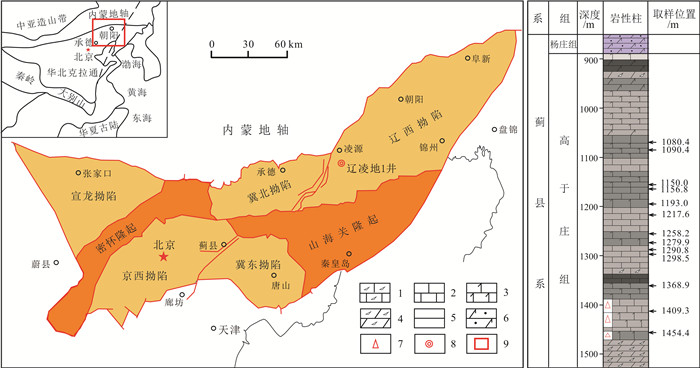
 下载:
下载:

